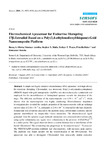| dc.contributor.author | Olowu, Rasaq A. | |
| dc.contributor.author | Arotiba, Omotayo | |
| dc.contributor.author | Mailu, Stephen N. | |
| dc.contributor.author | Waryo, Tesfaye T. | |
| dc.contributor.author | Baker, Priscilla | |
| dc.contributor.author | Iwuoha, Emmanuel | |
| dc.date.accessioned | 2019-04-16T08:45:06Z | |
| dc.date.available | 2019-04-16T08:45:06Z | |
| dc.date.issued | 2010 | |
| dc.identifier.issn | 1424-8220 | |
| dc.identifier.uri | http://ir.mksu.ac.ke/handle/123456780/4299 | |
| dc.description.abstract | A simple and highly sensitive electrochemical DNA aptasensor with high affinity for endocrine disrupting 17β-estradiol, was developed. Poly(3,4-ethylenedioxylthiophene) (PEDOT) doped with gold nanoparticles (AuNPs) was electrochemically synthesized and employed for the immobilization of biotinylated aptamer towards the detection of the target. The diffusion coefficient of the nanocomposite was 6.50 × 10−7 cm2 s−1, which showed that the nanocomposite was highly conducting. Electrochemical impedance investigation also revealed the catalytic properties of the nanocomposite with an exchange current value of 2.16 × 10−4 A, compared to 2.14 × 10−5 A obtained for the bare electrode. Streptavidin was covalently attached to the platform using carbodiimide chemistry and the aptamer immobilized via streptavidin—biotin interaction. The electrochemical signal generated from the aptamer–target molecule interaction was monitored electrochemically using cyclic voltammetry and square wave voltammetry in the presence of [Fe(CN)6]−3/−4 as a redox probe. The signal observed shows a current decrease due to interference of the bound 17β-estradiol. The current drop was proportional to the concentration of 17β-estradiol. The PEDOT/AuNP platform exhibited high electroactivity, with increased peak current. The platform was found suitable for the immobilization of the DNAaptamer. The aptasensor was able to distinguish 17β-estradiol from structurally similar endocrine
disrupting chemicals denoting its specificity to 17β-estradiol. The detectable concentration range of the 17β-estradiol was 0.1 nM–100 nM, with a detection limit of 0.02 nM. | en_US |
| dc.language.iso | en_US | en_US |
| dc.publisher | Molecular Diversity Preservation International | en_US |
| dc.subject | poly(3,4-ethylenedioxythiophene) (PEDOT | en_US |
| dc.subject | Aptamer | en_US |
| dc.subject | Modified electrode | en_US |
| dc.subject | Avidin/biotin | en_US |
| dc.subject | Square wave voltammetry | en_US |
| dc.title | Electrochemical Aptasensor for Endocrine Disrupting 17β-Estradiol Based on a Poly(3,4-ethylenedioxylthiopene)-Gold Nanocomposite Platform | en_US |
| dc.type | Article | en_US |

